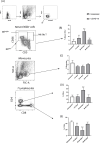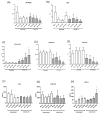Immunomodulatory effect of bovine lactoferrin during SARS-CoV-2 infection
- PMID: 39483459
- PMCID: PMC11524939
- DOI: 10.3389/fimmu.2024.1456634
Immunomodulatory effect of bovine lactoferrin during SARS-CoV-2 infection
Abstract
Introduction: Lactoferrin (Lf) is an important immunomodulator in infections caused by different agents. During SARS-CoV-2 infection, Lf can hinder or prevent virus access to the intracellular environment. Severe cases of COVID-19 are related to increased production of cytokines, accompanied by a weak type 1 interferon response.
Methods: We investigated the influence of bovine Lf (bLf) in the immune response during SARS-CoV-2 infection in vitro and in vivo assays.
Results: Our results show a strong binding between bLf and TLR4/NF-κB in silico, as well as an increase in mRNA expression of these genes in peripheral blood mononuclear cells (PBMCs) treated with bLf. Furthermore, the treatment increased TLR4/TLR9 mRNA expression in infected K18-hACE2 mouse blood, indicating an activation of innate response. Our results show that, when bLf was added, a reduction in the NK cell population was found, presenting a similar effect on PD-1 in TCD4+ and TCD8+ cells. In the culture supernatant of PBMCs from healthy participants, bLf decreased IL-6 levels and increased CCL5 in COVID-19 participants. In addition, K18-hACE2 mice infected and treated with bLf presented an increase of serum pro-inflammatory markers (GM-CSF/IL-1β/IL-2) and upregulated mRNA expression of IL1B and IL6 in the lung tissue. Furthermore, bLf treatment was able to restore FTH1 levels in brain tissue.
Discussion: The data indicate that bLf can be part of a therapeutic strategy to promote the immunomodulation effect, leading to homeostasis during COVID-19.
Keywords: COVID-19; TLR4; bovine lactoferrin; cytokines; immunomodulation.
Copyright © 2024 Silva, Machado, Nascimento, Rodrigues, Coelho, Tubarão, da Rosa, Bayma, Rocha, Frederico, Silva, Cunha, de Souza, Souza, Barros, Fiscina, Ribeiro, de Carvalho, da Silva, Muller, Azamor, Melgaço, Gonçalves and Ano Bom.
Conflict of interest statement
The authors declare that the research was conducted in the absence of any commercial or financial relationships that could be construed as a potential conflict of interest.
Figures





References
-
- WHO . Coronavirus (COVID-19) dashboard. Available online at: https://covid19.who.int (Accessed July 31, 2022).
-
- Xavier AR, Silva JS, Almeida JPCL, Conceição JFF, Lacerda GS, Kanaan S. COVID-19: clinical and laboratory manifestations in novel coronavirus infection. Jornal Brasileiro Patologia e Medicina Laboratorial. (2020) 56:e3232020. doi: 10.5935/1676-2444.20200049 - DOI
-
- Melgaço JG, Brito e Cunha D, Azamor T, da Silva AMV, Tubarão LN, Gonçalves RB, et al. . Cellular and molecular immunology approaches for the development of immunotherapies against the new coronavirus (SARS-CoV-2): challenges to near-future breakthroughs. J Immunol Res. (2020) 2020:8827670. doi: 10.1155/2020/8827670 - DOI - PMC - PubMed
MeSH terms
Substances
LinkOut - more resources
Full Text Sources
Medical
Miscellaneous

